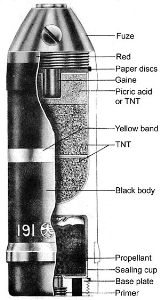
Ho-301 cannon
Encyclopedia
The Ho-301 was a Japan
ese 40 millimeter calibre autocannon
that saw limited use during World War II
, on Japanese Army Nakajima Ki-44
and Kawasaki Ki-45 KAI aircraft. It was unusual in using caseless ammunition
. Although the effective range of the cannon was only 150 meters (490 ft), the Ho-301 was light and rapid-firing for its caliber.
The caseless design revolved around a specially designed projectile, that was in effect a small rocket. The round used an internal propellent chamber at the rear of the projectile containing a ten gram silk bag filled with smokeless powder. Drilled into the base blade of the round are twelve 3.8 millimeter diameter exhaust holes. The propellent chamber is sealed by a thin aluminium sealing cup, which covers the exhaust holes. When the primer is struck, the bag of propellent ignites, and the pressure rises until the aluminium cup bursts, allowing the exhaust gas to rush through the exhaust holes pushing the projectile forward. The propellant was exhausted before the projectile left the barrel.
Because of the low muzzle velocity, the weapon was only suited to attacking bombers, and even here, the extremely low muzzle velocity made aiming difficult.
Japan
Japan is an island nation in East Asia. Located in the Pacific Ocean, it lies to the east of the Sea of Japan, China, North Korea, South Korea and Russia, stretching from the Sea of Okhotsk in the north to the East China Sea and Taiwan in the south...
ese 40 millimeter calibre autocannon
Autocannon
An autocannon or automatic cannon is a rapid-fire projectile weapon firing a shell as opposed to the bullet fired by a machine gun. Autocannons often have a larger caliber than a machine gun . Usually, autocannons are smaller than a field gun or other artillery, and are mechanically loaded for a...
that saw limited use during World War II
World War II
World War II, or the Second World War , was a global conflict lasting from 1939 to 1945, involving most of the world's nations—including all of the great powers—eventually forming two opposing military alliances: the Allies and the Axis...
, on Japanese Army Nakajima Ki-44
Nakajima Ki-44
The Nakajima Ki-44 Shōki was a single-engine fighter aircraft used by the Imperial Japanese Army Air Force in World War II. The type first flew in August 1940 and entered service in 1942...
and Kawasaki Ki-45 KAI aircraft. It was unusual in using caseless ammunition
Caseless ammunition
Caseless ammunition is a type of small arms ammunition that eliminates the cartridge case that typically holds the primer, propellant, and projectile together as a unit...
. Although the effective range of the cannon was only 150 meters (490 ft), the Ho-301 was light and rapid-firing for its caliber.
The caseless design revolved around a specially designed projectile, that was in effect a small rocket. The round used an internal propellent chamber at the rear of the projectile containing a ten gram silk bag filled with smokeless powder. Drilled into the base blade of the round are twelve 3.8 millimeter diameter exhaust holes. The propellent chamber is sealed by a thin aluminium sealing cup, which covers the exhaust holes. When the primer is struck, the bag of propellent ignites, and the pressure rises until the aluminium cup bursts, allowing the exhaust gas to rush through the exhaust holes pushing the projectile forward. The propellant was exhausted before the projectile left the barrel.
Because of the low muzzle velocity, the weapon was only suited to attacking bombers, and even here, the extremely low muzzle velocity made aiming difficult.
Ammunition specifications
- Length of projectile (fuzed): 129 mm
- Diameter of rotating band: 41 mm
- Diameter of body: 39 mm
- Wall thickness: 4 mm - 5 mm
- Weight: 0.590 kg
- Explosive content: 0.065 kg approx
- Fuze: Direct acting impact fuze

